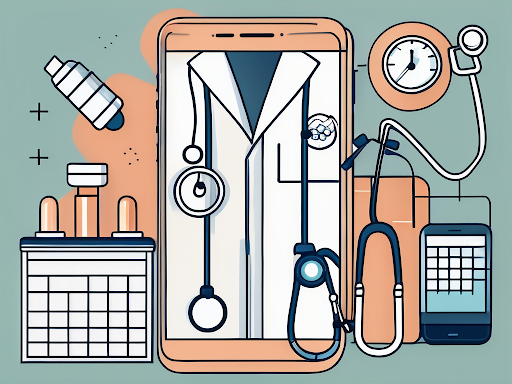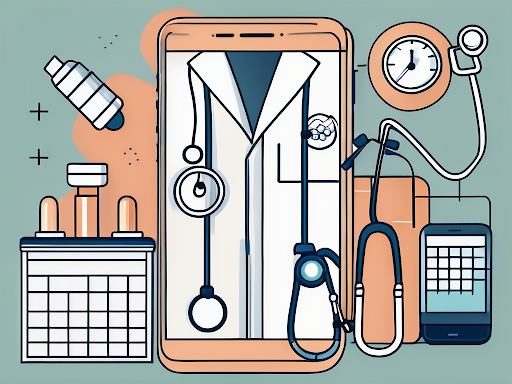
According to recent market research, the demand for mobile apps in the healthcare sector is on the rise. With the convenience it offers, an app for scheduling doctor’s visits can greatly streamline the process for both patients and healthcare providers. However, before diving into the app development process, it is crucial to understand the associated costs. In this article, we will explore the different factors that influence the cost of creating such an app, estimate the overall cost, and discuss strategies to reduce development expenses.
Understanding the Basics of App Development
Before delving into the cost estimation, it is important to understand the fundamentals of app development. Developing an app involves several key components that contribute to its functionality and user experience.
When it comes to app development, there are various stages that need to be considered. These stages include ideation, wireframing, designing, development, testing, and deployment. Each stage requires careful planning and execution to ensure a successful app.
During the ideation phase, it is crucial to define the purpose and target audience of the app. This involves conducting market research, analyzing competitors, and identifying unique selling points. By understanding the target audience’s needs and preferences, developers can create an app that caters to their specific requirements.
Wireframing is another important stage in app development. It involves creating a visual representation of the app’s layout and functionality. This helps in visualizing the app’s flow and identifying any potential usability issues before moving on to the design and development phase.
Key Components of a Scheduling App
A scheduling app typically consists of features such as appointment booking, calendar integration, push notifications, and patient profiles. Each of these components requires careful consideration in terms of design, development, and user experience.
Appointment booking is a crucial feature of a scheduling app. It allows users to easily schedule appointments with service providers or businesses. The design of the booking system should be intuitive and user-friendly, allowing users to select preferred dates, times, and services effortlessly.
Calendar integration is another important component of a scheduling app. It enables users to sync their appointments with their existing calendars, ensuring they never miss an important meeting or appointment. The integration should be seamless and support popular calendar platforms such as Google Calendar and Apple Calendar.
Push notifications play a vital role in keeping users informed about their upcoming appointments or any changes in the schedule. These notifications should be timely, relevant, and customizable to meet the preferences of individual users.
Patient profiles are essential for healthcare-related scheduling apps. They allow users to store and manage their personal information, medical history, and preferences. The design of patient profiles should prioritize privacy and security, ensuring that sensitive information is protected.
Importance of User Interface and Experience
A well-designed user interface (UI) and intuitive user experience (UX) are vital for the success of any app. Investing in a visually appealing and user-friendly interface enhances user satisfaction and encourages repeated usage, resulting in overall higher app engagement and success.
When designing the UI, factors such as color schemes, typography, and visual hierarchy should be considered. The choice of colors and fonts should align with the app’s branding and create a visually cohesive experience. Visual hierarchy helps users navigate through the app easily, highlighting important elements and guiding them through the desired actions.
UX focuses on creating a seamless and enjoyable experience for users. This involves optimizing the app’s navigation, minimizing loading times, and ensuring that interactions are intuitive and responsive. Usability testing is an essential part of UX design, allowing developers to identify any usability issues and make necessary improvements.
In conclusion, app development involves various stages and components that contribute to its success. Understanding the basics of app development, including key components and the importance of UI and UX, is crucial for creating a functional and user-friendly app.
Factors Influencing the Cost of App Development
Now that we have a basic understanding of app development, let us explore the factors that can significantly affect the cost of creating an app for scheduling doctor’s visits.
Developing an app for scheduling doctor’s visits involves various considerations that can impact the overall cost. In addition to the basic functionalities, there are several factors that need to be taken into account to ensure a successful and efficient app development process.
Design and Complexity of the App
The complexity of the app’s design greatly impacts the development cost. A simple and straightforward design will require fewer resources and development time compared to a more intricate and visually appealing design. However, it is important to strike a balance between aesthetics and functionality to create an engaging user experience.
When designing an app for scheduling doctor’s visits, it is crucial to consider the specific requirements of healthcare professionals and patients. The design should be intuitive, allowing users to easily navigate through different features such as appointment booking, doctor search, and medical history access.
Additionally, including advanced features like integration with electronic health records (EHR) systems or artificial intelligence (AI) algorithms will further increase the complexity, and thereby the cost, of development. These features can enhance the app’s functionality and provide users with a more personalized and efficient experience.
Platform Selection: iOS vs Android
Choosing the platform(s) for your app is another critical decision. Developing for both iOS and Android platforms will naturally increase the cost as it requires separate development and testing efforts. It is important to consider your target audience and their preferred platform when making this decision.
iOS and Android are the two dominant mobile platforms, each with its own set of advantages and considerations. iOS is known for its strong security measures and high-quality user experience, while Android offers a wider user base and greater customization options.
When developing an app for scheduling doctor’s visits, it is essential to ensure compatibility with the chosen platform(s) and optimize the app’s performance for different devices and screen sizes. This may involve additional development and testing efforts, which should be factored into the overall cost estimation.
Backend Development and Maintenance Costs
Backend development involves the creation of server infrastructure, databases, and APIs necessary for the application to work. The complexity of backend development and ongoing maintenance costs can significantly affect the total cost of the application. That is why in the modern world, there are already special calculators that will help you calculate the cost of creating apps.
For an app that schedules doctor’s visits, the backend development should focus on ensuring secure data storage, efficient appointment management, and seamless integration with healthcare systems. This may require the implementation of robust security measures, such as encryption and user authentication, to protect sensitive patient information.
Furthermore, ongoing maintenance and updates are crucial to keep the app running smoothly and address any potential issues or bugs. Regular updates may be required to accommodate changes in healthcare regulations, introduce new features, or improve the overall user experience. These maintenance costs should be considered when estimating the long-term expenses of app development.
Estimating the Cost of App Development
Estimating the cost of developing an app for scheduling doctor’s visits involves considering several factors.
Hourly Rates of App Developers
The cost of app development varies depending on the hourly rates of developers. The rates can vary significantly depending on the developer’s location, experience level, and expertise. On average, app development rates range from $50 to $250 per hour. Thoroughly researching and selecting a reputable development team within your budget is essential.
Timeframe for App Development
The overall cost of app development is heavily influenced by the amount of time taken to develop the app. Generally, more complex apps with advanced features take longer to develop, resulting in higher costs. Efficient project management and clear communication with the development team can help optimize the development process and reduce unnecessary delays.
Incorporating Additional Features
Adding extra features like telemedicine integration, secure messaging, or prescription management can enhance the functionality of the scheduling app. However, it is important to carefully consider the cost implications of these additional features. Prioritizing the essential features and gradually adding more functionalities as the app gains traction can help manage costs effectively.
Reducing the Cost of App Development
While developing an app for scheduling doctor’s visits can be a significant investment, there are strategies to reduce costs without compromising on quality.
Pre-Development Planning
Thoroughly planning the app’s features, design, and user flow before development begins can help minimize rework and unnecessary expenses. Conducting market research, identifying target users, and conducting usability tests early in the process can help fine-tune the app’s requirements and reduce development costs in the long run.
Outsourcing vs In-house Development
Deciding whether to outsource app development or establish an in-house development team greatly impacts cost. Outsourcing development to a reliable and experienced team can often be a cost-effective option, as it eliminates the need for hiring and training additional staff. However, it is crucial to conduct thorough research and due diligence when choosing an outsourcing partner.
Utilizing App Development Tools
The use of app development tools and frameworks can significantly reduce development time and cost. These tools offer pre-built components and templates that can be customized to suit the app’s requirements, saving both time and resources. However, it is important to balance the use of such tools with maintaining the uniqueness and performance of the app.
Calculating the cost of creating an app for scheduling doctor’s visits requires careful consideration of various factors and utilization of resources wisely. By understanding the basics of app development, identifying the key cost-influencing factors, and implementing cost-saving strategies, you can embark on the app development journey with confidence and success.









